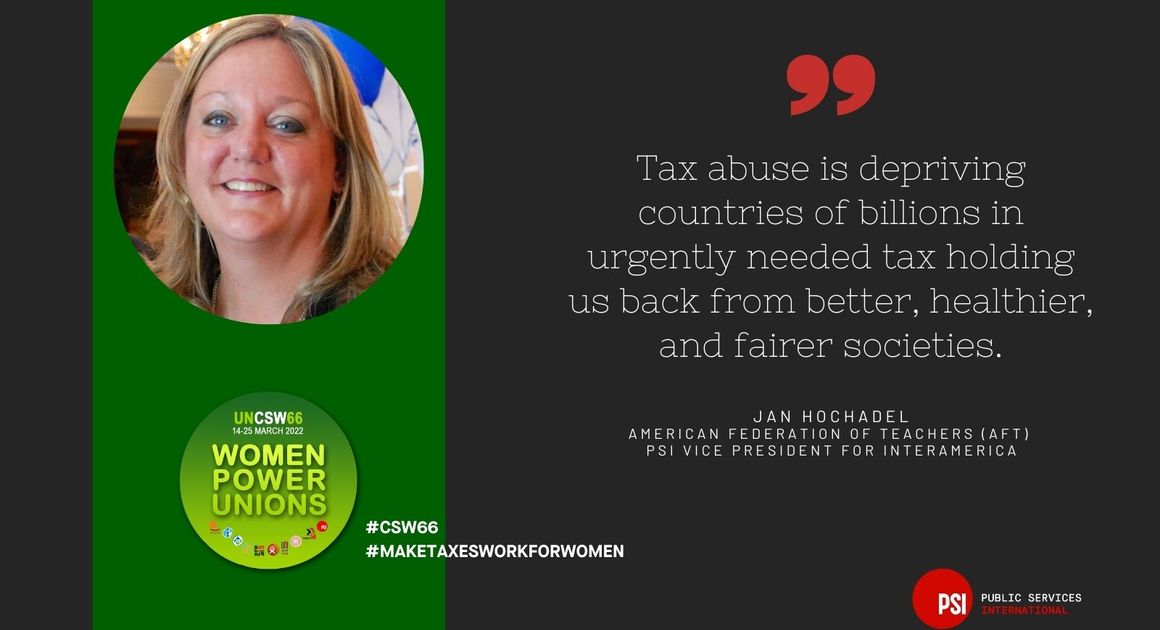Make Taxes Work for Women Taxes and education

Jan Hochadel, American Federation of Teachers (AFT) and PSI Vice President for Interamerica spoke at a parallel event to the CSW66, Shifting the narrative: Why we need progressive taxation to finance education, and the role of IFIs. The event is part of the Global Days of Action on Tax Justice for Women's Rights 2022
- Read this in:
- en

Comms
One thing modern history has shown us is that work often dominated by women, including healthcare, education, and other social services, are under-resourced and often undervalued in our global society. Our communities want the public services and acknowledge they are our one of our greatest asset, but what’s gotten lost is the understanding that these services are necessary to protect the common good and something we should take pride in, and invest in.
How has this happened? Well, it will come as no surprise to anyone as it has been mentioned many times so far, that large corporations, while hopscotching across the globe looking for countries who will provide them with the greatest wealth (while making them paying the least taxes) – have provided the funds that have drastically changed the narrative. Where I am in the US, we see all sorts of ads portraying these corporations as working for the communities and paying their fair share of taxes – which, unfortunately, too many people in society now believe – when in fact they pay very little taxes and are doing great harm to society. Globally, tax cheats have deprived the public sector of more than $427 billion dollars a year. And Corporations have gotten away with this for too long.
My home in the United States is in the state of Connecticut, just a few miles north of New York City. It is a very small state, it takes just about an hour to drive from one corner to another. And in our state, we have some of the wealthiest communities side-by-side with some of the poorest communities in the nation. CT is by most measures among the wealthiest states in the country, but it is also a state with tremendous wealth disparity.
What happens when we see such wealth disparity? Imagine, just over the border of New York City, is the town of Greenwich, Connecticut – one of the wealthiest communities in America. Home to the CEOs, hedge fund managers, and celebrities. Here we see schools with the best and newest amenities, with new ventilation and heating/cooling systems, modern classrooms with the best technology, and well-paid educators. They are also among the safest schools - We see schools with bulletproof bookshelves that slide in front of windows with the push of a button.
And just about 25 miles north of Greenwich is Bridgeport, one of the poorest cities in the state, and not surprisingly, one of the least funded school systems. It has dilapidated buildings, old classrooms with little or outdated technology, poor ventilation, and underpaid staff. The disparity of wealth in such a short distance is indescribable.
And this is because in CT, public services (including education) are funded primarily with local and state tax revenue – and the local taxes are determined by local policy makers. Wealthier suburban towns – like Greenwich – use zoning laws to maintain the “traditional charm” of their towns. And they pass regulations that limit the number and location of multi-family homes and apartment complexes. Housing values are kept high, the number of residents is kept relatively low, and so the town can afford to invest in robust public schools.
The disparity between the money available for urban schools – such as Bridgeport - is also affected by the amount of land available to be taxed. And I should mention, Government buildings do not pay property taxes, and are of course, more prevalent in urban areas. More importantly, some of the colleges and hospitals in Connecticut – though they often have huge endowments and cash reserves – are officially non-profits and therefore do not pay taxes.
Of the ten poorest cities in Connecticut, nine of them have hospitals; the four poorest cities have two hospitals each. An extreme example is New London, a city of 26,000 people on only 6.6 square miles of land. With a hospital, three colleges, and several government buildings, nearly half of their land is non-taxable – and so the citizens have to make up the difference. The city budget is inherently stressed; and not surprisingly, their educators are among the lowest paid in the state.
There are also state taxes that also go towards education. In CT, we have what is called an Educational Cost Share formula, which determines the amount of funding that goes to each city or town. Apart from the fact the formula has not been modified in years, the legislators tend to “make deals” to get their communities more funding, leaving the urban areas even more massively underfunded. It’s imperative that states like CT develop a more equitable tax structure, and it also needs to look at a more equitable way to get the necessary funds to the neediest communities.
In 2020, our global union federation, Public Services International (PSI) along with the Tax Justice Network and the Global Alliance for Tax Justice highlighted that Tax abuse is depriving countries of billions and billions in urgently needed tax, which is holding us all back from building better, healthier, and fairer societies – which includes the great equalizer, education. One of the statistics from Liz’s work that I found – and it may have been mentioned - said that if we recovered the lost money from the tax abuse we would have enough to pay the yearly salaries of 34 million nurses (or in our case, teachers).

True commitment to a just society, means everyone fairly contributes to how society runs, (through a system of taxation that is equitable). What is happening is that corporations are gaming the system, dropping their earnings into a shell corporation to hide it – because their main goal is not the common good, it is to make more wealth for shareholders. So called “nonprofits” earn incredible amounts of money that they then hide from public auditors in offshore accounts or in tax shelters. As a result, our communities, and especially Women and families, suffer the consequences.
Taxes are meant to be equitable so that all contribute to our common good, including education. We must support a progressive taxation system to ensure that a community has enough revenue to complete that mission. Communities – and those that make policies – aren’t doing enough to ensure that companies help our taxpayers shoulder the revenue burden to fund our social services.
While we applaud the World Bank and other international financial institutions for the work they have done to correct past wrongs, they must do more. Global support should focus on more than capitalist success. IFI’s must also support and create public structures that will set up global communities for long term stability and success.
The education sector, in fact the public sector in general, is finding more college grads are leave the profession for more lucrative careers. The truth is that you can try tax incentives and other options to help recruit and retain teachers, however as Julie mentioned in the beginning, nothing will be able to overcome the low salaries, high cost of healthcare, and lack of adequate retirement options - in our field until there is a fair tax structure.
I urge you to take a look at how funding is raised for your public structures and your education systems. Analyze who is paying their fair share for the common good and call out those who are not. Lobby your elected leaders to change the narrative, for our communities, for our children and for our workforce.
Articles: